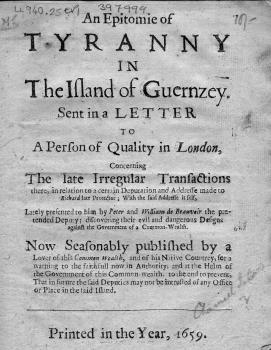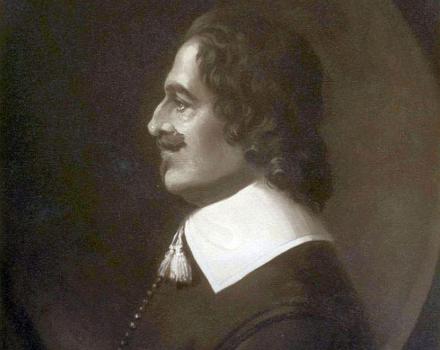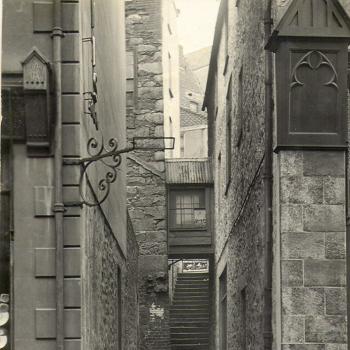Colonel Edward Popham reports on his search for Prince Charles, who was suspected of attempting to take refuge in Jersey, which he had already visited in 1646. Popham must have missed him, because Charles did find his way to Jersey in that month, and stayed until February of 1650.

Oliver Cromwell died on September 3, 1658. The States sought to send an address of condolence and loyalty to his son, 'his highness' Richard Cromwell, but were prevented from doing so by the Lieutenant-Governor, Captain Charles Waterhouse, who found their petition 'too submissive.' The leader of the republican party, Pierre De Beauvoir des Granges (1599-1678) and William De Beauvoir du Hoummet, potentially a less committed republican, wrote a defiant letter to Waterhouse, pointing out the Guernsey public's many grievances against him, and proceeded to sneak out of Guernsey and present their petition to Cromwell anyway, taking the opportunity to plead for the unpopular Des Granges to remain as Bailiff. Their actions prompted the publication of a pamphlet, An epitomie of tyranny in the island of Guernsey, which can be found in the Library. It was published anonymously at the beginning of 1659, and accuses the De Beauvoirs of all kinds of misdemeanors.
Reminiscences, from The Star, Tuesday December 9, 1890. The reaction of the population to the shocking event: a translation of an Ordinance of the Royal Court of 11 January, 1673; and an account from Roger North's Life of Dr John North, a 17th century Cambridge academic who was related to the Hattons. The illustration of the Castle before the explosion is a print published by Richard Godfrey in 1779, taken from a painting then in the possession of a [Mr] Carey.
A report from The Guernsey and Jersey Magazine of 1837. Historical Notices of the Channel Islands, 8, taken from Pierre Carey's private papers. This Pierre [Peter] Carey is the Parliamentary Commissioner who later made a daring escape from imprisonment in Castle Cornet. A transcription of his letter book is in the Library.
From the Acts of the Guernsey Colloquy, a document of exceptional local importance in the Library Collection. The Gathering of Ministers and Elders gives its judgment.
From the notebook of Pierre Le Roy, as printed in The Guernsey Magazine of 1874. With notes from the Library MS Peter Mollet's Notebook; and an eyewitness account from the Reverend Thomas Le Marchant. The illustration is from an engraving by Baillie based on a watercolour by Joshua Gosselin of five companies of the 83rd Royal Glasgow Volunteers encamped on the Moulin des Monts. Gosselin also painted another view of the Moulin des Monts, which is in the Guernsey Museum collection.
Mr Havilland's house is consumed by fire: two accounts, one from Jean de la Marche's diary, the other from George Fashion's notebook. The photograph is of the Ruette Marie Gibaut (colloquially Fuzzey's Lane), in St Peter Port, in 1936, from the Library Collection.
According to Jean de la Marche, on Sunday, August 5, 1636, the Earl of Danby was 'out hunting in his Island of Herm, whither he had taken the greater part of the Gentlefolks of the Town (although by so doing they profaned the Day) and he having given his Horse the Spur, it ceased not to rear and turn round and round until it had thrown him to the Ground.'
In 1610 Lord George Carew replaced the late Sir Thomas Leighton as Governor of Guernsey. Upon being called almost immediately back to England he left instructions for Amias De Carteret, his Lieutenant-Governor. This is an extract from a letter he wrote to De Carteret, dated 9th August 1610, at Castle Cornet, taken from Tupper's Chronicles of Castle Cornet, 1849.
Another interesting letter from the physician Sir Thomas Browne to his son, describing his beloved daughter Elizabeth's voyage from Guernsey in May 1682 to visit him in Norwich, in the King's yacht Monmouth. Browne died later that year.




